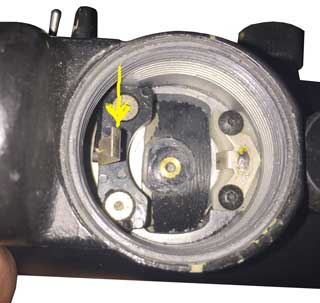AN/PVS-4 Starlight Scope
Night Vision Sight, Individual Served Weapon
© Brooke Clarke 2012 -
2022
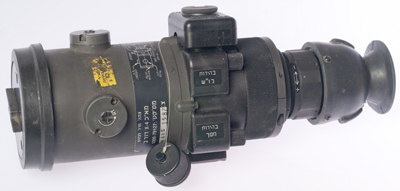
Background
WARNING
PVS-1
Description
Image Tube
Reticule
Lamp
Insert
Mount
FN FAL
Manuals
Battery Caps
Related
Links
Background
Got this as a basis for developing a
battery adapter. This night vision scope uses the same
BA-5567/U battery as the
PVS-5 Night
Vision Goggles, but the cap threads on this scope are male
and also different from those on the PVS-5 so they require
different battery adapters.
Wiki lists
these variants: AN/TVS-5, AN/PVS-8, AN/PVS-20, NVS-700, NVS-800,
Auto NVS-1, Auto NVS-2, NVS-T 700, NVS-T 800, IWS NL-84, NL-87,
NL-89, Star-Tron, MVM-4, ITT F4960. I don't know if these
have the same battery cap?
When the 95mm objective of the PVS-4 replaced with a 155 mm
objective it's then called the TVS-5. Note the larger objective
has more than twice the area so the ranges for the TVS-5 are more
than double those of the PVS-4.
WARNING
Many optical devices, including the Starlite Scopes, made use of
Thoriated glass (
Wiki).
This can be a severe radioactive hazard for anyone exposed to it
for prolonged periods of time. For most applications, like
objective lenses, this is not a problem. The problem comes
about with prolonged exposure to flesh, like the case of an
eyepiece made of Thoriated glass that emits alpha, beta and gamma
rays. also see
Radiation Detectors.
Ref 1:
Eyepiece Lens of Army Starlite Scope Found to Contain Thorium,
Night Vision Sight Sub Assembly MX-7833A/PVS-2 - NRC:
ML063530621.pdf
Ref 2:
Eye Exposure from Thoriated Optical Glass, US Army (
W3B_13.PDF)
- This 1968? survey started out looking for radiation related to
the high voltages used in many devices since Cathode Ray Tubes
generate X-rays (
Wiki),
but they found instead that the glass used in some eyepieces was
radioactive.
MX-7793/PVS-1
The first in the PVS- series was the MX-7793/PVS-1. Photos
courtesy of Clint.
Also see: -
"Fight
at Night" U.S. Army Night Vision, 1945-1980 -
Description
This is a early version made for use
in Israel. It has provision for 2 batteries to be mounted.
One of them is fitted with an add-on double AA battery adapter.
The night vision tube works.
The optics appear to be of the
Cassegrain
reflector (Wiki)
design. This has big advantages when working with visible
light in addition to infrared light because there's no chromatic
abberation (Wiki)
which is a problem associated with using glass for a lens.
The other advantage is that the physical length is much shorter
than a prime focus telescope because of the folding.
I'm thinking of adding a Picatinny rail (
Wiki) =
MIL-STD-1913 = STANAG 2324 to the PVS-4 to make it more universal
in application. Then with a rail mounted on a camera tripod
this scope would be good for
astronomy.
Although first used just for mounting scopes it's now used as a
general purpose mounting system.
Note that when you press your eye against the rubber eye cup the
central two flaps will open. This way when no one is looking
through the scope and the power is on it does not act like a green
light flashlight.
The rearmost (smaller diameter) ring is the diopter
adjustment. Just in front of it is the (larger diameter)
objective focus adjustment.
Mounting brackets were available for:
Model
|
Caliber
|
| M16A1 |
5.56 mm |
| M14 |
7.62 mm |
| M79 |
40 mm |
| M203 |
40 mm |
M72A2
|
66 mm
|
M60
|
7.62 mm |
M67
|
90 mm
|
It's not clear if the simple bracket shown on this scope is a
standard part and all the other brackets attach to it, or if this
tripod mount is removed to allow other brackets to be installed.
I've read, but not yet checked, that when looking directly into
the objective that IR light is being radiated if the reticule is
illuminated. The
PAS-6 IR viewer
would work for this.

|
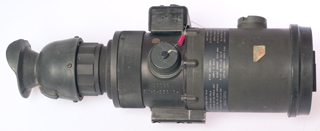
|
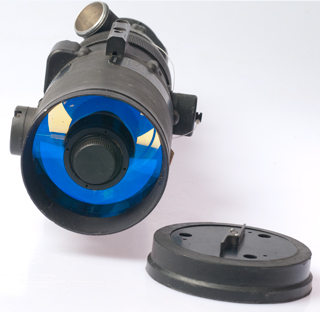
|
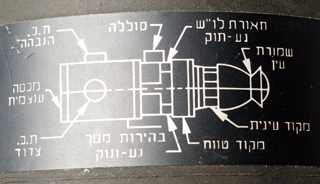
|
Carry Bag:
80063-SM-D-850482-1, MFR. 2S308
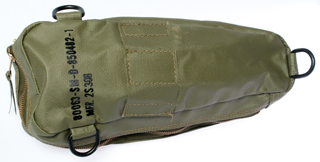
|
|
Image Tube
The stock image intensifier tube is the MX 9644 and the 3rd
generation replacement tube is the 11620 UV, both are 25mm diameter tubes.
See Wiki: PVS-4
Design Details
The same MX-9644 is used in the VVS-2
Tank Drivers Night Viewer.
Reticule
The reticule and it's lamp are located at the front center behind
a cap.
Lamp
The reticule lamp is a red LED mounted behind the front
lens center cover.
Testing the three unit assembly showed an open circuit.
But after separating the three parts and testing the LED
it tested good.
After reassembly the lamp is now working.
This is a very common problem with old equipment caused by
oxidation.
See: Hints & Tips - What Goes
Wrong
|

|
Insert
Even though the LED emits
red light when viewing through the eyepiece the reticule
appears as green. At the top it says:
7.62/5.56. It does not match any of the reticules
shown on the Wiki
page.
|
|
Mount
This mount is a simple bar with the common U.S. 1/4-20 tripod
threads. So this particular scope probably was used for
night surveillance rather than on a weapon.
No need to fit a Picatinny rail since it now fits my existing
photographic
tripods. Most
likely to use on the
Arriflex tripod
because it's very sturdy can can carry the weight.
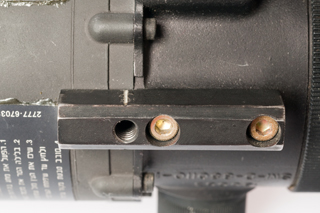
|
|
FN FAL
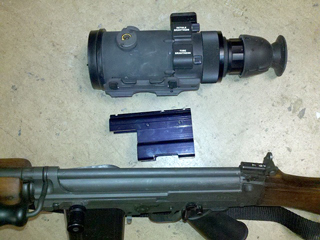
|
|
Manuals
TM 11-5855-213-10 Operator's Manual,
Night Vision Sight, Individual Served Weapon, AN/PVS-4 (NSN
5855-00-629-5334), 1 Feb 1993
TM 11-5855-213-23&P Unit and Direct Support Maintenance Manual
(Including Repair Parts and Special Tools List) for Night Vision
Sight, Individual Served Weapon AN/PVS-4 (NSN 5855-00-629-5334), 1
June 1993
PVS-4 Battery Caps
The PVS-4 Night Vision Sight,
Individual Served Weapon (
Wiki) has
female threads on the sight and male thread on the cap, opposite
of the
PVS-5. Also the thread
pitch is different.
To develop a battery adapter for the PVS-4 I will need a PVS-4
(the model that uses the BA-5567 battery) so that the battery
compartment can be measured.
It does not need to work or even have the image tubes.

|
Stock PVS-4 Cap
|
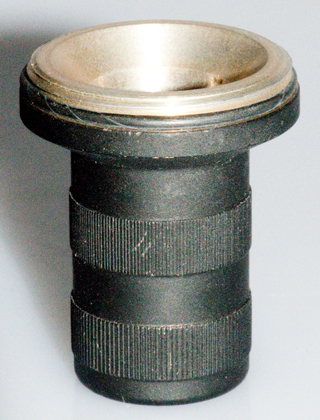
|
Top Hat CR123 Batt Adapter
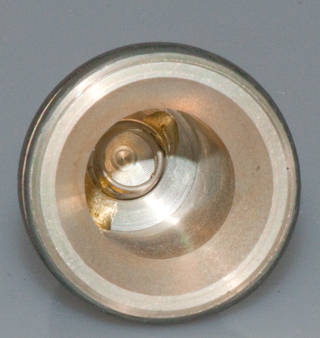
|
1XEP3 Battery Adapter
2 AA

|
Marked:
Adapter Battery
U.S. 80063
A300 9873
SP0920-04-V-4124
M.F.G. 1XEP3

|
|

|
Related
Optics
M227 M-227 Signal Lamp Equipment SE-11 -
Gun shaped flashlight, trigger, relay, IR Filter option
M18 IR Binoculars - near IR not hot people
or car engines
PAS-6 Metascope IR viewer and source
T3C - Russian monocular Image Intensifier
(star light scope)
TVS-2 Crew Served Weapon Sight
MD-1 Automatic Astro Compass - also can
see stars in the daytime
Astro-Compass for sighting Sun &
stars
Periscopic Aircraft Sextant - Sun &
stars
NextStar60 - cleaver microcontroller
telescope using DC motors and shaft encoders
Orion - 9x63
binoculars
- When the objective diameter (63 mm) is divided by the power (9X)
if the exit pupil size (7 mm) is around 7 mm then the binocs are
designed to be used with night adapted eyes, like for looking at
the stars or to see things on the ground you could not see with
bare eyes. I once watched a dear swimming while being chased
by a dog just after Sunset. Although I could not see
anything with my bare eyes, I could see fine with a pair of 7X50
binocs. See my
Binoculars
page for more on star gazing binocs.
Celestron 8" Telescope
with Equatorial wedge and tripod- This model has a clock drive but
no computer control. It's big and heavy, not something you
pull out for a quick 5 minute look up. Would be much better
if used with a permanent pier. It takes quite some time to
do a Polar alignment, but when done you can find about anything
just using the hour angle and declination scales.
Cloud Detection - used as part of an
automated observatory
Hughes
Probe Eye far IR viewer
PVS-5A Night Vision Goggles
UAS-4 Infrared Surveillance System,
AN/AAS-14 Infrared Detecting Set, MK-898/AAS-14A Optical Filter
Kit
VVS-2 Tank Driver's Night Viewer
Links



